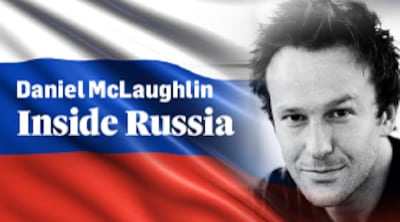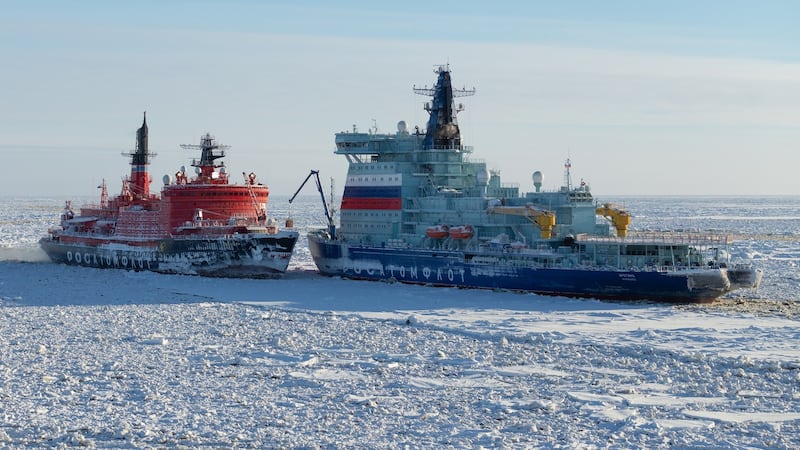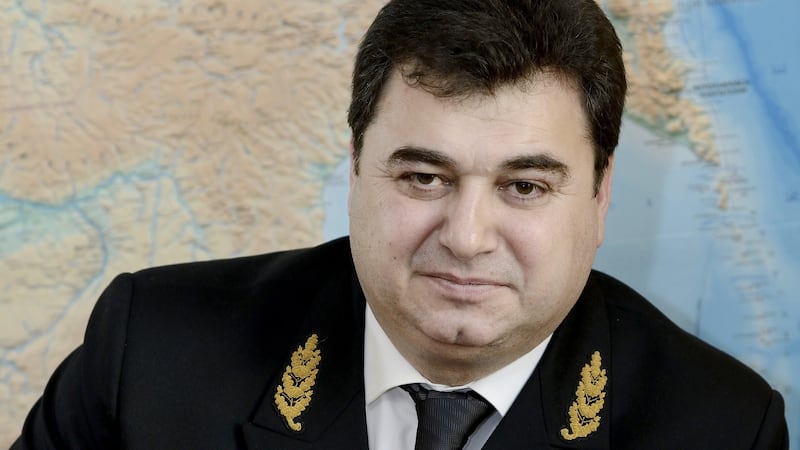At noon on the eve of Murmansk’s “polar night”, a stretch of 40 days when the sun will not breach the horizon in this northern Russian city, the lights on the deck of the Lenin twinkle through the Arctic twilight.
Hard-packed snow blankets the dock after a blast of minus-20 weather, but it is warm and bright inside the world’s first nuclear-powered icebreaker, which now welcomes visitors during its retirement in this port on a bay of the Barents Sea.

The Lenin’s reactors were shut down in 1989, three decades after it first plied the forbidding Northern Sea Route (NSR), where its mighty successors now play a key role in Russia’s plans to develop – and perhaps dominate – the Arctic.
More than half of the Arctic Ocean's coastline is Russian territory, and about 2 million of the entire region's 4 million residents live in Russia, including 300,000 in Murmansk, the biggest city in the Arctic.
Moscow is now investing billions of euro on extracting energy, metals and precious rare earths from the region, and on building and modernising army and air bases and radar stations, to guard growing civilian infrastructure and ward off attention from Nato states that are also increasing their activity in the Arctic.
The NSR is not only the main transport link for remote Russian communities, bases and factories, but also a strategic and economic asset for the country, as global warming thins ice cover and boosts the Arctic's potential to offer a shorter, cheaper year-round route between Asia and Europe for ships that now use the Suez Canal.
Navigation of the far north will remain immensely challenging and unpredictable, however, as demonstrated in November when 24 ships on the NSR became trapped in ice that thickened and locked earlier than expected.
Icebreakers
That costly and potentially dangerous situation highlighted the importance of Russia’s icebreakers, and the logic behind the Kremlin’s decision to invest in a new generation of the unique atomic-powered fleet that began with the Lenin in 1959.
The fleet is operated by Atomflot – a Murmansk-based arm of Russian state nuclear power company Rosatom – which initially did not have atomic icebreakers available in the right area of the NSR to assist the ice-bound ships last month.
"The favourable ice conditions of recent years distorted the understanding of some ship owners about what it means to work in the eastern reaches of the NSR," says Mustafa Kashka, director general of Atomflot.
Icebreakers have now freed all the struggling vessels, but Kashka says companies should in future “pay more attention to which ships are chosen for operations in the last months of summer-autumn navigation, and co-ordinate their activities in a timely way . . . with Atomflot.”
The Arctic is warming on average twice as quickly as the rest of the planet, and the NSR is now navigable for most commercial ships for a few months of the year, but Kashka says he expects the route to continue freezing during its long winter and spring seasons for at least the next three decades.
“It is impossible to imagine the efficient use of the waters of NSR without nuclear icebreakers,” he warns.

Russia has about 50 icebreakers, and the Kremlin wants nine atomic-powered vessels to be sailing the Arctic by 2035, up from five at the moment; by contrast, the US has only one operational icebreaker, which was launched in 1973.
The most powerful icebreaker ever built, named the Arktika, returned to its home port of Murmansk this week after undergoing repairs in Saint Petersburg, and will now return to work along the NSR as the first of five new ships of this class, which are designed to smash through up to three metres of ice.
"Our country is the undisputed leader in mastering northern territories," Russian premier Mikhail Mishustin said at the handover of the Arktika to Atomflot last year, after major problems and delays dogged its construction and testing.
“We are proud that Russia is alone in the world in having managed to create an atomic-powered icebreaker fleet . . . This series of icebreakers will fully open up the potential of the Northern Sea Route and strengthen the interest of international business in this new transport corridor between Europe and Asia,” he declared.
“And, of course, it will ensure the supremacy of Russia in the Arctic.”
Savings on cargo
The NSR can offer huge savings in time and costs if the potentially crippling hazard of ice can be avoided or overcome: sailing from Japan to the Netherlands, for example, can be some 5,000km shorter via the Arctic route than through the Suez Canal.
Officials are demanding massive expansion at breakneck speed, however. In 2020, almost 30 million tons of goods travelled via the NSR, only 1.3 million tons of which were transiting Russia; by 2030, the government wants 150 million tons of cargo to be moving through the Arctic Ocean, 30 million tons of them in transit.
Kashka says the NSR will handle a total of about 35 million tons of cargo this year, and will ramp up as Russia builds everything from new port infrastructure and ships, to satellites that will aid communication and weather and ice forecasting.

Just as Russia’s icebreakers are central to its plans to open up the NSR to year-round shipping, so its floating atomic-power plants are intended to deliver electricity to remote Arctic coast communities and industrial complexes.
Atomflot says these reactors can power a town of 100,000 people, and the first one produced, called the Akademik Lomonosov, was loaded with nuclear fuel in Murmansk in 2019 and towed 5,000km east along the NSR to the port of Pevek, where it now supplies residents and industry; several more such units have reportedly been ordered for mining operations in the far north.
Kashka says they represent “one of the most promising directions for development in world atomic energy, including as regards the need for stable sources of energy supply in remote territories with limited network infrastructure.”
Some environmentalists see floating reactors as potential time bombs, which compound the danger posed by Russia’s rapid development of oil, gas, mining, transport and military infrastructure to the fragile ecosystems of the Arctic.
The EU highlighted rapid warming of the far north, melting permafrost and other environmental concerns when it unveiled its new strategy on the region in October, and said its “full engagement in Arctic matters is a geopolitical necessity”.
“Intensified interest in Arctic resources and transport routes could transform the region into an arena of local and geopolitical competition and possible tensions, possibly threatening the EU’s interests,” the European Commission warned.
The bloc also said it wanted an international ban on new oil, gas and coal exploration in the Arctic, which Russian officials immediately decried as a bid to stop Moscow benefiting from its vast energy reserves in the area.
Nato concerns
Russia says it is more concerned by Nato military hardware and war games near its northern borders, and denounced the temporary deployment this year of several US bombers to Norway, an Arctic state just 150km from Murmansk; next year, it will host its biggest war games inside the Arctic Circle for decades.

"As it seems today, we will have about 40,000 soldiers in exercise Cold Response," General Eirik Kristoffersen, head of the Norwegian Armed Forces, told the Barents Observer newspaper.
“It will be the largest military exercise inside the Arctic Circle in Norway since the 1980s,” he added. “There is a significantly increased interest among our allies for the north and the Arctic.”
Russia is also intensifying military activity in the Arctic, deploying attack aircraft and new missile and radar systems in the region, preparing MiG-31 fighter-interceptor jets to guard the NSR, and upgrading the status of the Northern Fleet, based near Murmansk, to make it the nation’s fifth military district.
Russia’s Arctic neighbours say much of its military activity in the region is covert – such as electronic intelligence gathering, signals jamming and computer hacking – but Moscow is not averse to publicly flexing its muscles in the far north.
In September, some 8,000 Russian troops, 120 aircraft and 50 warships conducted Arctic exercises, six months after manoeuvres that culminated with three atomic submarines surfacing simultaneously within 300 metres of each other by smashing through 1.5 metres of ice.
Russian president Vladimir Putin said it was a first, "which had no equivalent in the history of the Soviet period or the history of modern Russia".
“We will continue complex Arctic expeditions, researching and mastering the far north, to ensure the military security of the Russian Federation.”
Territorial claims
Amid increasing competition, tension and rival territorial claims in the Arctic – where in 2007 a Russian submersible planted the nation’s flag on the resource-rich seabed – even distant China has declared itself a “near-Arctic state” and started developing plans for a “polar silk road” to boost trade along the NSR.
"The Arctic, with its harsh climate, has long been touted as a region of relative stability and peaceful co-operation. Unfortunately, this may not hold for much longer," Dmitri Trenin, director of the Carnegie Moscow Centre, wrote this year.
“Looking ahead, climate change, environmental protection, and the opening of sea-lanes for commercial navigation require international co-operation. To make this possible, confidence-building measures in the Arctic are in order.”
Yet the region is rapidly becoming embroiled in the power struggle that already dominates contact between Russia and the West from the Baltic to the Black Sea.
Moscow has progressively tightened restrictions on the operation of non-Russian ships in the NSR, and reportedly may ban foreign vessels from conducting a host of civilian operations along the route next year.
The news emerged this week, as Sweden's defence minister Peter Hultqvist hosted British counterpart Ben Wallace in Swedish Lapland, where they called for closer western co-operation in the Arctic and vigilance over Russia's intentions.
The chilly relations would have been familiar to the Soviet sailors who guided the Lenin through the frozen Arctic during the depths of the cold war, and Kashka says their Russian successors on today’s atomic icebreakers share their particular talents.
“Boatmasters effectively apply tactics and strategy to manoeuvre in the ice. Mechanics have long experience of safely using nuclear power plants,” he explains.
“The special qualities of our ships’ crews include readiness to provide help, and endurance and self-control. The seamen of the nuclear icebreaker fleet have unique abilities, which make them number one in the Arctic.”











